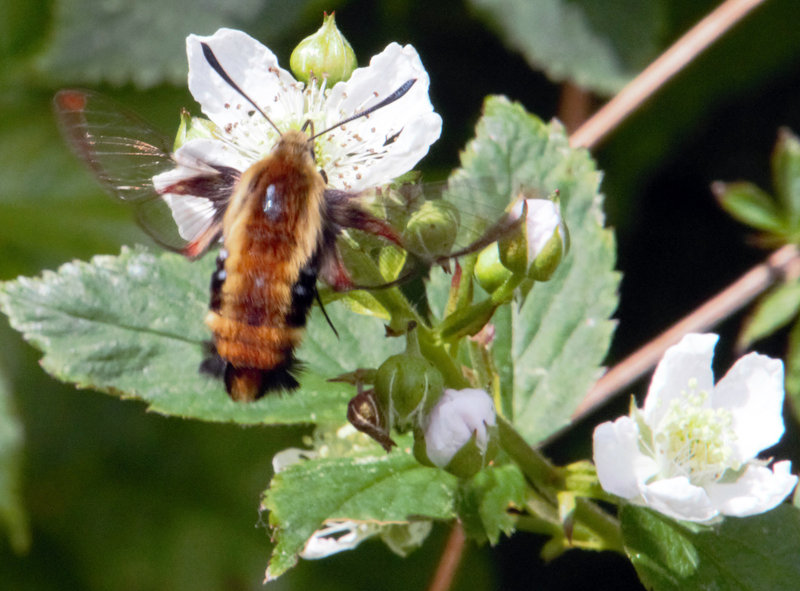Back to August 2017 Newsletter
The Snowberry Clearwing Moth

Kim Fellows
The snowberry clearwing moth (Hemaris diffinis) is a member of the Sphingidea family of moths, commonly called "hummingbird," "sphinx," or "hawk" moths. In West Virginia, they are also known as “flying lobsters”! These moths are fairly large, with heavy bodies and a wingspan that can reach 5 cm or more in some species. Strong and fast fliers, members of the Sphingidae have a rapid wingbeat. Unusually for moths, the members of this family are day-flyers.
The snowberry clearwing moth is more prevalent east of the continental divide. Its cousin, the hummingbird clearwing moth, has colouration that resembles a ruby throated hummingbird. These moths can be found in a wide variety of habitats, including streamsides, fields, gardens, and suburbs.
The adult moths hover in front of a flower and sip nectar through their unfurled proboscis (tongue), just like a hummingbird. The proboscis rolls up when not in use. Native plants that you may see a hummingbird moth frequent include bluebells (Mertensia), bee balm (Monarda), honeysuckle (Lonicera), Verbena, Lantana, and snowberry (Symphoricarpos).
All moths and butterflies have scales covering their wings, but the clearwing species lose many patches of scales on their first flight, thus rendering the wings clear or transparent.
In most species, the larval stage is called a "hornworm" because the caterpillar's posterior end has a harmless hook or hornlike appendage protruding upward. Many gardeners will be familiar with the dreaded tomato hornworm, which is the caterpillar stage of the beautiful five-spotted hawkmoth.
Depending on the species, these caterpillars may eat the leaves of viburnums, honeysuckles, snowberry, blueberries, and members of the rose family. The clearwing moths pupate in a thin cocoon in leaf litter, where they remain during the cold months, emerging as moths in late spring or early summer.
Bumble Bee Citizen Science Update
Remember last year, when Friends of the Earth Canada launched the Great Bumble Bee Count? You can check the results from last year to see how many bees were identified. This year Friends of the Earth is asking for your help again, by keeping your keen eye and camera focussed on bumble bees. Download their census card to help identify bees in the field, take photos, and upload them to your account. Online identification guides will further help you identify your bees before submitting them for verification by scientists. The last date to be included is September 15th. Let it Bee!
**
Kim Fellows is Pollination Canada's outreach coordinator.
Photo: Snowberry Clearwing Sphinx Moth (Hemaris diffinis), Ontario, Canada. By Wayne W G. CC BY-NC-ND 2.0.
Not yet a member?
An annual membership to Seeds of Diversity gives you access to our seed exchange, seed grow-out programs, and our online news.

We depend on donations to do our work.

Thank you for your support!
